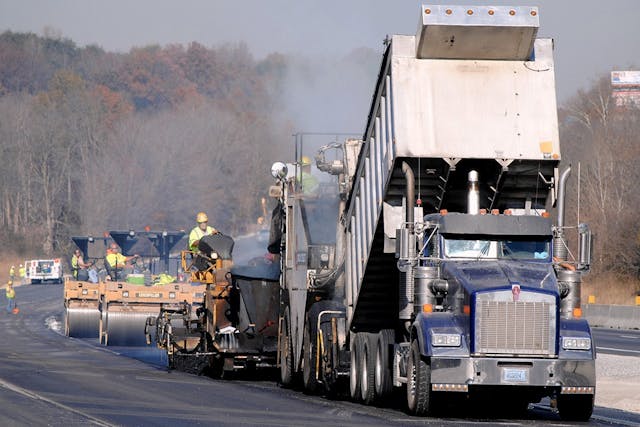Opening the Secrets of Hot Mix Asphalt Technology
Checking out the depths of hot mix asphalt innovation reveals a world where precise formulas and thorough procedures assemble to shape our roads and infrastructure. The blend of fillers, aggregates, and binders isn't merely a building and construction task yet a strategic orchestration of durability and performance.
Significance of Hot Mix Asphalt
Hot Mix Asphalt plays a crucial function in modern-day facilities advancement as a result of its sturdiness and cost-effectiveness. As one of the most generally used leading product for roadways, freeways, and parking great deals, Warm Mix Asphalt supplies a variety of benefits that add to its importance in building tasks. One vital advantage is its capability to endure rush hour tons and harsh climate conditions, supplying a resilient and reliable surface for transport networks. Additionally, Warm Mix Asphalt is cost-efficient in both first building and long-term maintenance, making it a preferred choice for several framework jobs.
The sturdiness of Warm Mix Asphalt stems from its make-up, which consists of accumulations, binder, and filler materials that are thoroughly picked and blended to fulfill particular performance needs. Generally, the relevance of Warm Mix Asphalt in infrastructure growth can not be understated, as it proceeds to be a keystone of modern-day building practices.
Components of Asphalt Mixes
The structure of asphalt mixes is composed of carefully selected accumulations, binder, and filler products that are important for achieving details efficiency demands. Aggregates are the primary component of asphalt blends, giving strength and security. The binder, usually asphalt or asphalt concrete, holds the accumulations together and supplies versatility and durability to the mix.
The combination and percentage of these parts play a considerable duty in establishing the quality and efficiency of the asphalt mix. Engineers meticulously make the mix to meet specific needs, taking into consideration elements like traffic quantity, environment problems, and sidewalk life-span. Correct option and harmonizing of accumulations, binder, and fillers are vital for developing long lasting, durable asphalt sidewalks.
Combining and Manufacturing Techniques

When the aggregates are picked, the binder, often asphalt cement, is added to bind the products together. The binder's high quality and quantity significantly impact the mix's resistance, stamina, and adaptability to environmental elements. Additionally, fillers like moisturized lime or Rose city concrete might be included to enhance details characteristics of the asphalt mix, such as its workability or dampness resistance.
During production, the accumulations and binder are warmed, usually between 250-325 ° F(121-163 ° C ), to facilitate mixing and make sure appropriate covering of the accumulations. The blending process needs to be thorough to achieve an uniform combination that promotes the desired efficiency attributes of the asphalt. Various techniques, such as batch blending or drum mixing, are used to attain premium and constant asphalt mixes for building and construction tasks.
Factors Influencing Asphalt Efficiency
Factors affecting asphalt performance incorporate a series of variables that impact the longevity, durability, and general top quality of asphalt pavements. One essential variable is the top quality of materials used in the asphalt mix. The type and source of aggregates, the binder quality, and the ingredients all play a considerable role in identifying the see this efficiency of the asphalt pavement. The gradation of accumulations is essential as it affects the mix's workability, resistance, and security to rutting and breaking.

Layout factors to consider, such as pavement density and drainage, are necessary in guaranteeing the long-term performance of the asphalt pavement. By very carefully thinking about these designers, specialists and aspects can optimize asphalt efficiency and enhance the solution life of sidewalks.
Sustainable Practices in Asphalt Technology

WMA permits for the production and positioning of asphalt mixes at reduced temperature levels contrasted to conventional hot-mix asphalt, resulting in lowered energy intake and greenhouse gas discharges. The use of permeable asphalt mixes can aid reduce stormwater runoff concerns by allowing water to infiltrate via the pavement and right into the ground, promoting natural water purification and recharge procedures.
Conclusion
Finally, hot mix asphalt modern technology plays an essential duty in contemporary infrastructure growth because of its sturdiness and cost-effectiveness. By thoroughly stabilizing elements, using appropriate blending methods, and considering different factors, engineers can produce high-grade asphalt mixes that hold up against heavy website traffic tons and rough weather. Embracing sustainable techniques, such as using reference warm-mix technologies and recycled products, further improves the environmental kindness of asphalt technology.
Mixing and production strategies in hot mix asphalt technology include the exact mix and processing of aggregates, binder, and fillers to create a high-performance and durable asphalt mix.Factors affecting asphalt performance include a range of variables that affect the toughness, long life, and total quality of asphalt pavements. Sustainable practices in asphalt technology encompass various initiatives aimed at reducing the environmental impact of asphalt production and paving processes. By integrating reclaimed asphalt pavement (RAP) and recycled asphalt roof shingles (RAS) into new asphalt mixes, the sector can substantially reduce the intake of raw products Going Here and energy, while also lowering land fill waste.
WMA permits for the production and placement of asphalt mixes at reduced temperatures contrasted to conventional hot-mix asphalt, resulting in reduced energy usage and greenhouse gas emissions.